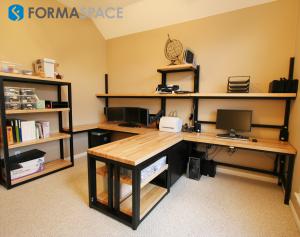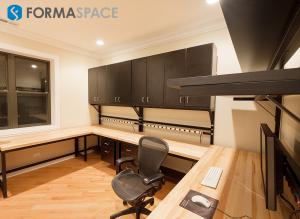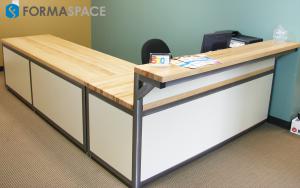How to Design Your Home Office to Fit Your Function
Do you permanently or occasionally work from home? Read our tips on how to create your comfortable and productive work space in your home.
It’s essentially an extension of your work office built in your home — a place where you can step inside and instantly be productive when you get that late night email from a customer or your boss.”
AUSTIN, TEXAS, US, April 3, 2017 /EINPresswire.com/ -- Do you work from home these days?— Formaspace
As it turns out, more and more of us are doing just that.
According to the Survey of Income and Program Participation (SIPP) and the United States Census Bureau, about 9 percent of us (13.4 million workers out of 142 million) worked at home at least one day a week in 2014. That’s up 35% for the decade. And it’s the so-called Knowledge Workers in the computer, engineering and science fields that are really driving the the “working from home” model — their numbers increased 69% over the decade, with 432,000 of them working from home in 2014.
As we look around the country for regional trends, Boulder, Colorado was the breakout star, with 10.9% of workers working primarily from home. The Austin, Texas region —home of Formaspace — led the pack with more than 7% of this region’s employees working at home.
Interestingly, the US Census notes there’s a definite regional trend underway: employers based in the West are much more likely to allow employees to work from home.
When designing your home office, you should determine ‘Which kind of Home Office Worker are you?’
The U.S. Census breaks home-based workers into three categories:
“Home Workers” who work at home exclusively
“Mixed Workers” who split their time between home and a remote office
“Onsite Workers” who work exclusive at a remote office.
But from our experience as suppliers of Home Office furniture and storage solutions, we go further. We break it down into seven categories, based on the type of work you’ll be doing from home.
The seven categories are:
1. The “Always On” Home Extension of the Work Office
2. The Growing “Hobby” Home Office
3. The Delivery-Based “Transactional” Home Office
4. The Small Repair Service Home Office
5. The Vacation Rental Home Office
6. The Personal Services Home Office
7. The Traditional Home Office
The “Always On” Home Extension of the Work Office
Workers who constantly take their work back and forth between home and work need to create a space we call the “always on” home office.
It’s essentially an extension of your work office built in your home — a place where you can step inside and instantly be productive when you get that late night email from a customer or your boss.
The key tips for the “Always On” office space are:
- Maintaining sound privacy from other members of the household when the office needs to be used later at night or early in the morning.
- Conditioned power and battery backup as well as robust networking and VPN connections. Well-thought-out cabling connections that keep the jungle of wires under control so you have a neat and tidy place to work.
- A well-fitted ergonomic chair, and a Formaspace sit-to-stand computer workstation or desk that allows you to change positions throughout the day at the touch of a button, for improved circulation and better health.
- Storage lockers with key access to protect sensitive documents and possibly a fireproof safe as well.
- You may also need provisions for videoconferencing and a table for collaborating with coworkers or other guests who may join you at your private office at home.
The Growing “Hobby” Home Office
Many of us are exploring and investing major amounts of time (and a not an inconsiderable amount of money) into hobbies, some of which we intend to pursue as a small business venture in the future.
This category includes hobbies like photography, scrap-booking, sewing, model making, 3D printing, cake decorating, crafting and many many more.
The key tips for a growing hobby home office include:
- Providing generous amounts of built-in cabinets and secure storage for all your equipment and materials.
- Work benches and tables to spread out large projects.
- Flexible, modular furniture components that allow you to reconfigure your layout as your needs change.
- Built-in task lighting to support detailed hand work.
- Space for multiple people to occupy the office comfortably for group projects.
- Sit-to-Stand work surfaces that let you change position during the day to reduce fatigue and stress.
The Delivery-Based “Transactional” Home Office
Many home-based entrepreneurs are trading on internet retail sites such as eBay and Etsy. Most discover very quickly that they have to replicate a scaled-down version of a receiving, storing, packing and shipping warehouse in their home.
The key tips for the delivery-based transactional home offices include:
Read more ... https://formaspace.com/articles/office-furniture/design-home-office-to-fit-your-function/?utm_source=einpresswire&utm_medium=content&utm_campaign=061616
Kelsea Marshall
Formaspace
8002511505
email us here
Legal Disclaimer:
EIN Presswire provides this news content "as is" without warranty of any kind. We do not accept any responsibility or liability for the accuracy, content, images, videos, licenses, completeness, legality, or reliability of the information contained in this article. If you have any complaints or copyright issues related to this article, kindly contact the author above.



